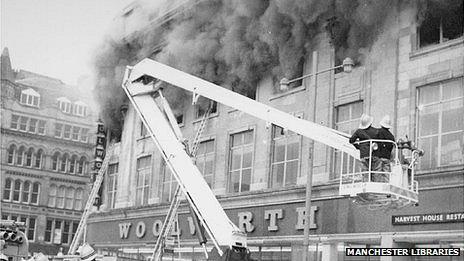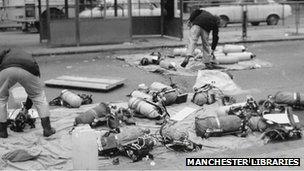What happened in the 1979 Manchester Woolworth fire?
- Published

It is thought around 500 people were in the store when the fire broke out
Artist Elizabeth Price has won the Turner Prize for her video installation, The Woolworths Choir of 1979, 2012.
The work uses old music, photographs, video footage and text to depict a tragic fire at a Woolworth's branch in Manchester in 1979, in which 10 people died.
The artist said it was "a way to remember" what was the worst shop fire in the city since World War II.
What happened?
At around 13:30 BST on Tuesday 8 May 1979, a radio operator from a taxi firm called 999 to say that one of their drivers had seen smoke coming out of the Woolworth store opposite Piccadilly Gardens in the centre of Manchester.

Fire crews used breathing apparatus so they could reach those trapped inside the store
Her call was followed by 11 others and fire crews were dispatched to the store.
Crews arrived to find smoke billowing from the six storey building and people calling for help from the windows. It is thought there were around 500 customers and staff inside the store at the time.
Firefighters fought for two-and-a-half hours to bring the fire under control, helping people out of the building via doors, windows and the roof.
At 15:51 BST, officers declared that the fire was surrounded and a thorough search of the building was carried out.
By that point, 10 people had lost their lives, 47 were taken to hospital for treatment and six fire officers had been injured.
Why was the fire so deadly?
The fire was, at the time, the city's worst fire disaster since World War II and the fire service identified three reasons why it was so deadly.

It took crews around two-and-a-half hours to bring the fire under control
The first was that it started after a damaged electrical cable ignited furniture made of polyurethane foam, which produced large amounts of thick toxic smoke.
The smoke not only caused breathing problems but also obscured the exit signs.
The investigation into the fire found most of those that died were in the restaurant on the second floor, but the smoke was so thick, they could not find their way to the exits.
The second reason was that the store had no sprinkler system, which meant it was not until fire crews arrived that any real effort could be made to extinguish the flames.
The final reason was that the upper windows of the store had thick iron bars on them.
Fire crews made attempts to pry the bars off the windows with axes and crowbars, but were unsuccessful and had to wait for specialist cutting machinery to arrive.
As a result, there was a delay in allowing the windows to be used as a means of escape.
What was the legacy?
After the investigation into the cause of the fire found the foam used to fill the budget furniture was to blame for the smoke, Fire Officer Bob Graham decided something had to be done to ensure that such a tragedy could not happen again.
He had led the investigation and after it, he joined with other campaigners to persuade the government to change the law and oblige furniture makers to use flame-resistant foam.
In 1988, The Furniture and Furnishings (Fire) (Safety) Regulations, external came into effect, forcing manufacturers to make furniture fillings and covers from safer materials.
- Published4 December 2012